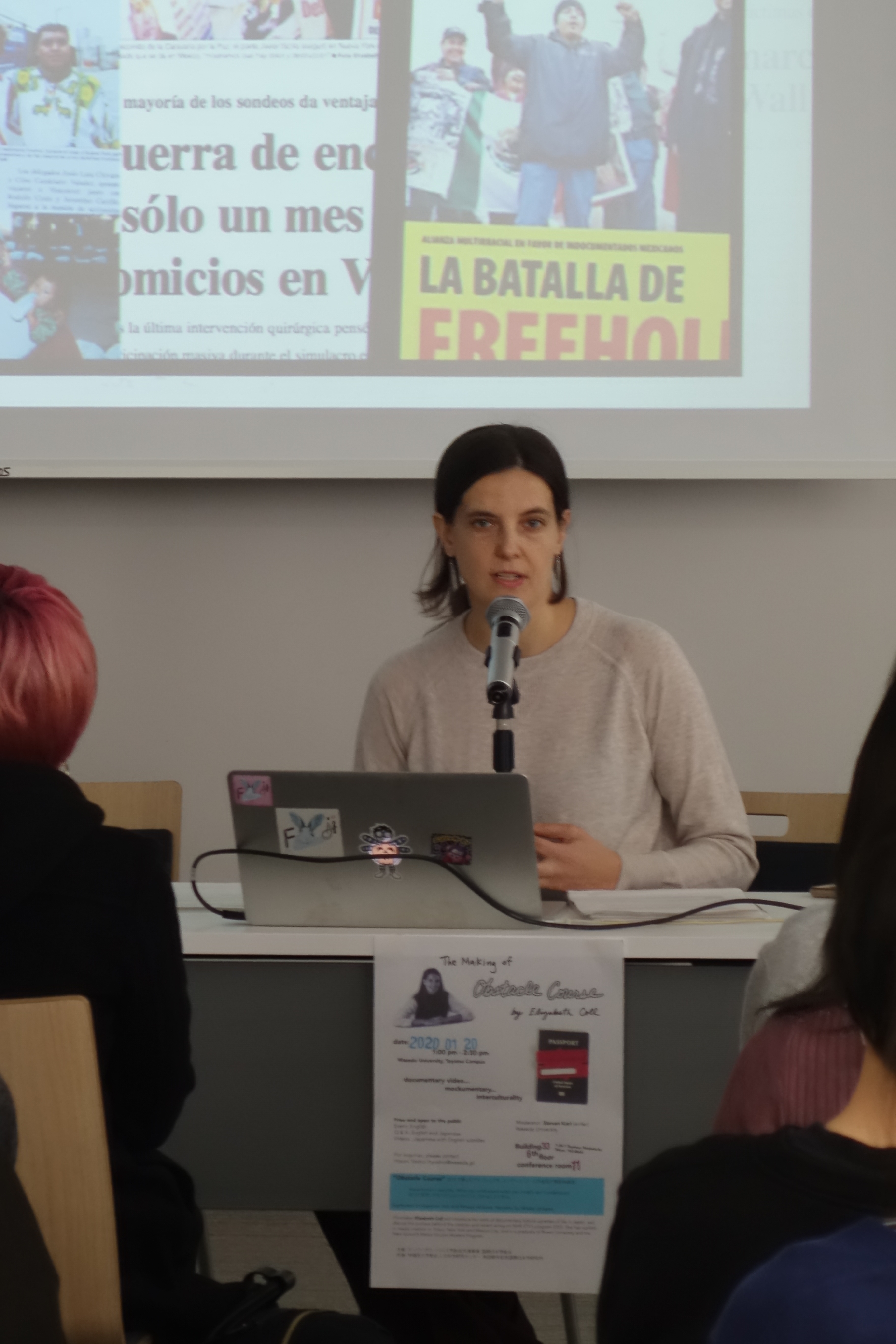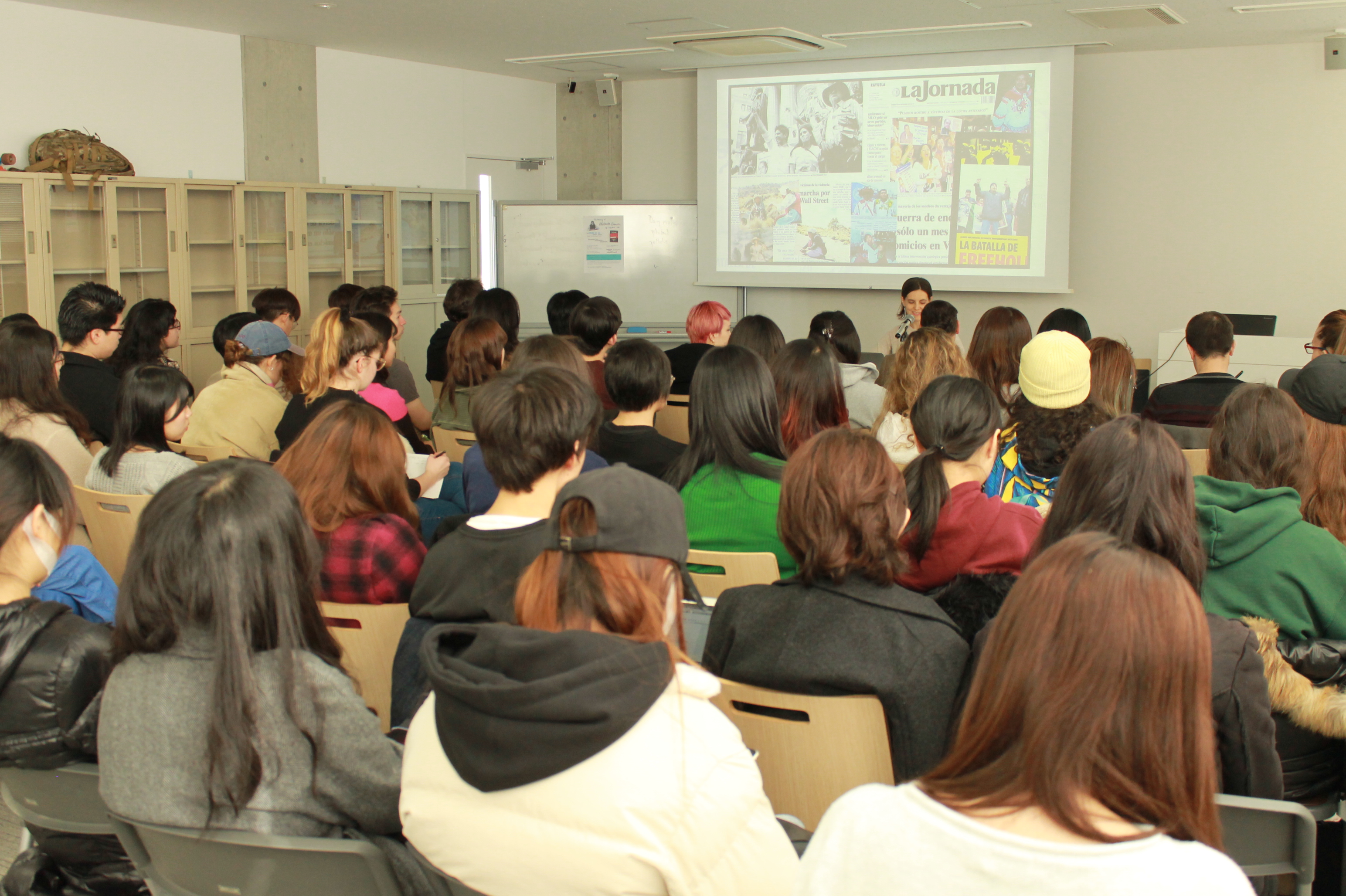The Making of Obstacle Course by Elizabeth Coll
On January 20, 2020, Waseda University hosted a lecture by filmmaker Elizabeth Coll, where she introduced her work of documentary hybrid vignettes of life in Japan, and discussed the process behind the creation and recent airing on NHK ETV’s program 2355. Entitled “The Making of Obstacle Course by Elizabeth Coll,” the event was moderated by poet and Waseda lecturer Steven Karl, who delivered a short introductory address to attendees before turning the floor over to Ms. Coll.

Coll first shared her personal history with the audience. After receiving her B.A. in Latin American Studies at Brown University, she began her career as a photographer and writer for Spanish language publications in the U.S. and Mexico, and lived in Mexico for seven years. She returned to the U.S. to complete an M.A. in Media Studies from The New School in New York, where she met her husband and musician Kenji Ozawa. After traveling around the world together for three years, she collaborated with him as a visual creator for his concert tour, and eventually moved to Japan with their two children. With regards to this recurrent change of locations throughout her life, from the U.S. to Mexico to Japan, she explained: “I have always been looking at one culture in the context of another.” Then, making direct reference to her work, she said that she enjoyed “that feeling of stretching out to build a bridge from one point of view to another.”
Titled Obstacle Course, these documentaries are short vignettes in which a protagonist encounters several “obstacles” after moving to Japan, each of them a product of cultural differences. Three of her short videos were screened during the event. In the first video, “Hanko,” the just-arrived-to-Japan protagonist needs to obtain a hanko (a Japanese personal seal) and is puzzled by the process, which at the same time makes her think about the many and intricate regulations of Japanese society. The second video, “Mine or Ours?” comically explores the protagonist’s challenges in conforming to rules regarding dress and table etiquette. When the same protagonist goes to a ryokan (Japanese traditional inn), she is puzzled over what the protocol is to enjoy the shared bath. The third video, “Who Are you? And Where Am I?,” introduces scenes from New York City, offering a comparative perspective in thinking about different interpretations of signs such as clothing and other visual cues. All of these experiences make the protagonist reflect on presuppositions and shared understandings that are always operating when living in a certain culture.

Coll explained that misunderstanding and difficulty were a constant of her experience in Japan and that she tried to turn them into the essence of her work. “Obstacles are a fertile ground for creativity,” she said. While narrating the process of creating her videos, Coll drew upon scholar Mary Louise Pratt’s concept of “contact zone” to compare the making of the videos with her collaborators to one of these contact zones in which intercultural discussion and exchange take place constantly. She also related the concept of this intercultural “contact zone” to scholar Homi Bhaba. Culture is not located on one of two poles of a spectrum, from where it enters in contact with another culture. Instead, culture is the contact itself, a “third space” in which there is no propriety of either side, just a mere sharing and interconnection. “It is possible to consider intercultural exchange a third space that can elude the politics of polarity,” she explained.
Coll mentioned several other important aspects of her work and her creative process. She described the impact that the narrator, Mikako Ichikawa, had on herself. “She ended up being a voice that is now part of myself,” she claimed. Coll also elaborated on the difficulties of moving both to Japan and to Mexico. Reflecting on the experiences of Mexican immigrants she had written about in the U.S., she said, “Immigrants want to feel welcomed and included. Treated as a person. That there is room for us. A seat. That people see you,” once again stating that misunderstandings and obstacles are in themselves a possibility for such inclusion to occur. Finally, she discussed the documentary filmmaker Albert Maysles, whom she described as one of her biggest influences. According to Maysles, a documentarian is “an author, but not a director. A discoverer, not a controller.” That you “happily place your fate and faith in reality. It is your caretaker.” She concluded, “Thanks to Albert Maysles, I realized that what I wanted to say should not come from myself, but from the world, and that I would be lucky if I could catch just a bit of it.”

In the Q&A portion of the event, Coll was first asked about the lack of faces shown in her videos, to which she answered that it was, first of all, to preserve the anonymity of the actors, but even more so to make any viewer feel represented by the film. She was also asked about other examples in which the intercultural “contact zone” widens and/or narrows, to which she responded with examples of her personal life and by asserting that intercultural encounter implies comprehending that “the more one knows, the less one understands.” She was finally inquired about her thoughts on filmmaking. Quoting once again Albert Maysles, Coll closed the event by saying that the most important thing is “to feel the shooting, to feel love and compassion for the material being documented.”
■Event Overview
The Making of Obstacle Course by Elizabeth Coll
Event Date & Time: January 20, 2020, 1:00pm-2:30pm
Location: Conference Room 11, Building 33, 6th Floor, Toyama Campus, Waseda University
Speaker: Elizabeth Coll (Filmmaker)
Moderator: Steven Karl (Poet & Adjunct Professor, Waseda University)
Organizer: Hitomi Yoshio (Associate Professor, Waseda University)


